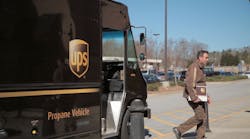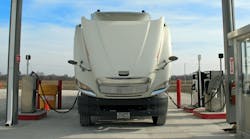When it comes to selecting an alternative fuel, fleets have a number of factors to consider. Those factors increase exponentially as the size of the fleet expands.
Three of the largest parcel delivery companies in the world have embraced alternative fuels for their vehicles, and as a result, are achieving energy-reduction goals and making positive impacts to the environment, as well as to their bottom line.
Mike Britt, director of maintenance and engineering – international operations, UPS ( www.ups.com ) – a global logistics provider, including transporting packages and freight – says his company has more than 7,200 alternative fuel trucks on the street and has invested more than $750 million globally in alternative fuel and advanced technology vehicles and fueling stations since 2009.
“Our goal is to reduce carbon expenditure, reduce operating costs and be a good steward of the environment. Alternative fuel use is one part of that equation,” he explains.
Britt says there are a number of key methods to reducing overall fuel use, such as:
- Reducing miles driven by using advanced algorithms for more efficient route design.
- Using the right truck for the right route.
- Deploying automotive maintenance technologies like telematics to reduce overall maintenance.
- Improving operating performance.
Likewise, Rae Lyn Rushing, media relations spokesperson at FedEx (www.FedEx.com) – a provider of transportation, e-commerce and business services – explains her company has a similar focus on reducing its environmental impact and is committed to conserving energy by finding alternative renewable fuels.
“We have a defined, high-level strategy: reduce, replace, revolutionize,” explains Rushing, adding the first step is optimized routes to reduce mileage driven. “Replacing vehicles is next, so we’ve also introduced more efficient models with 4-cylinder, sub 3L diesel engines – which are much more efficient – and maximized fuel economy by reprogramming vehicles to run at optimal levels for their weight and load.
“Excitingly, we’re also focused on new technology – the revolutionize phase. We’re looking at electric vehicles, fuel cells and hybrids, among others.”
FedEx has nearly 1,900 alternative-fuel vehicles in its fleet.
DHL (www.DHL.com) – a global market leader in the logistics industry employs a “burn less, burn clean” focus on alternative fuels. The “burn less” portion focuses on reductions of fuel and energy use, while the “burn clean” objective emphasizes a shift to cleaner alternative energy sources.
DHL is a part of Deutsche Post DHL Group (www.dpdhl.com), a world-wide postal and logistics organization that offers several delivery services.
“Deutsche Post DHL Group was the first global logistics company to set itself a carbon efficiency target, with the aim to improve our CO2 efficiency by 30 percent until the year 2020, compared to 2007,” Achim Juechter, senior expert, fleet technologies, Deutsche Post DHL Group says.
GREEN DECISIONS
Choosing an alternative fuel is not a decision that can be made quickly or arbitrarily. It takes time for fleets to research new technology and devise a plan to implement it.
For example, FedEx Express teamed with the non-profit environmental advocacy group Environmental Defense Fund (www.edf.org) on a project to make delivery trucks more environmentally friendly in 2000. As a result, in 2004, the first commercially available hybrid delivery truck was placed into service on FedEx Express routes.
“We believe the wider adoption of alternative fuel and advanced technology vehicles will play a critical part in reducing global GHG emissions,” FedEx’s Rushing explains.
There are a number of alternative fuel options available to fleets. Among others, current alternatives to gasoline and diesel fuels include:
- Synthetic diesel.
- Renewable natural gas (RNG).
- Compressed natural gas (CNG).
- Liquid natural gas (LNG).
- Liquid propane gas (LPG).
- Electric.
- Hybrid electric.
- Hybrid hydraulic.
- Ethanol.
- Hydrogen fuel cells.
- Bioethanol.
- Bio-dimethlether.
- Biodiesel.
- Biomass-to-liquid (BTL)
- Hydrotreated vegetable oils (HVO).
According to UPS’ Britt, the company has been utilizing any and all alternative fuels that may benefit the company for approximately 10 years, with a major deployment beginning in 2012.
At this time, UPS feels natural gas provides the best overall benefit for the company’s Class 8 fleet, while some form of hybrid electric vehicle works best for its Class 6 trucks.
“We use all the major alternative fuels available that make sense for our fleet,” says Britt. “Choices are made based on geographic availability – southern states, for example, have a reliable supply of LNG, but northern states do not – and available infrastructure such as fueling stations.”
Recognizing that there is not one, single “silver bullet” solution, DHL’s testing of alternative fuels intensified in 2005.
“The ‘burn less, burn clean’ strategy itself was set in place in line with the foundation of our environmental program GoGreen in the year 2008. Since then, the introduction of alternative fuels to our fleet is a continuously ongoing process,” DHL’s Juechter says, noting that the company recently began serial production of its own electric delivery vehicle, Streetscooter, and has plans to produce 2,000 units.
“Over the past years, we have tested a broad range of alternative fuels,” he continues. “The final choice on a fuel application is typically made based on four factors.”
These factors are:
- Operational feasibility.
- Environmental benefits.
- Economic impact.
- Local applicability, covering the aspects of market availability and legislative approvals.
What’s more, the choice of fuel in a market can vary depending on factors like vehicle class and type of operational usage, different regional fuel and fuel infrastructure availability, cost differences and other factors.
“Today, over short ranges, we mainly apply electric drives and gaseous fuels like CNG in our fleet, while in long distance operations, we rely on liquid fuels like LNG or HVO,” Juechter says.
TRAINING
Implementing alternative fuel vehicles involves more than selecting a fuel and installing equipment on a vehicle. Both drivers and technicians need to be educated on how to use and maintain the fuel and related components.
For example, to get the desired savings, operators may need to drive the vehicles a specific way.
“Advanced propulsion vehicles do need a different drive skill set to operate than conventional vehicles,” Britt of UPS notes.
“Depending on the solution applied, driver training can be a crucial factor for success,” DHL’s Juechter agrees. “Different fuels can lead to changes in which a vehicle needs to be handled and driven. In these cases, the full potential of solutions can only be achieved with corresponding driver training.”
Similarly, maintenance practice adjustments and technician training may be required to keep alternative fuel vehicles operating at peak efficiency.
“This accounts – for sure – for all kinds of electric drives,” Juechter says.
CHALLENGES VS BENEFITS
Again, making a switch to alternative fuels can feel complicated for fleets. While the benefits of adopting alternative fuels continue to grow, a number of challenges still exist.
“Reducing the environmental impacts of our industry is a complex and pressing challenge. We work with government and industry organizations on regulatory and policy changes that help the transportation industry reduce emissions and improve performance,” FedEx’s Rushing says.
Britt of UPS says challenges of implementing alternative fuels include:
- Geographic availability.
- Infrastructure, such as fueling stations.
- Shop upgrades, like ventilation systems and alarms needed to handle certain alternative fuels.
- Technical training for technicians, especially with electric propulsion platforms.
However, he says there were also immediate benefits, like:
- Emission reduction.
- Economic benefit from some alternative fuel vehicles, such as LPG tractors that can be cheaper to maintain.
“The main challenge in establishing alternative fuels is to have a synchronized approach across all involved stakeholders – vehicle manufacturers, fuel providers, users and policy makers – to achieve an operationally, feasibly and economically viable application,” Juechter of DHL explains.
If these sectors of the industry can work together, he says the application of alternative fuels can lead to carbon benefits, lower local emissions and lower noise pollution.
Pursing alternative fuels also can improve a company’s reputation, as many Americans desire a reduction in pollution across many industries. A good faith effort to reduce its carbon footprint can reflect favorably on a fleet.
While challenges still exist for alternative fuel adoption, continued investment – combined with supportive government policies and a collaborative set of partners – has helped expand development and utilization of alternative fuels, vehicles and infrastructure throughout the world.




